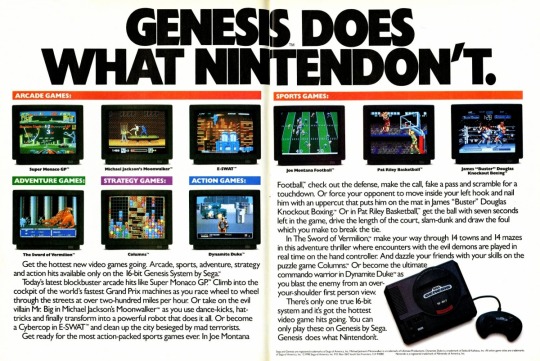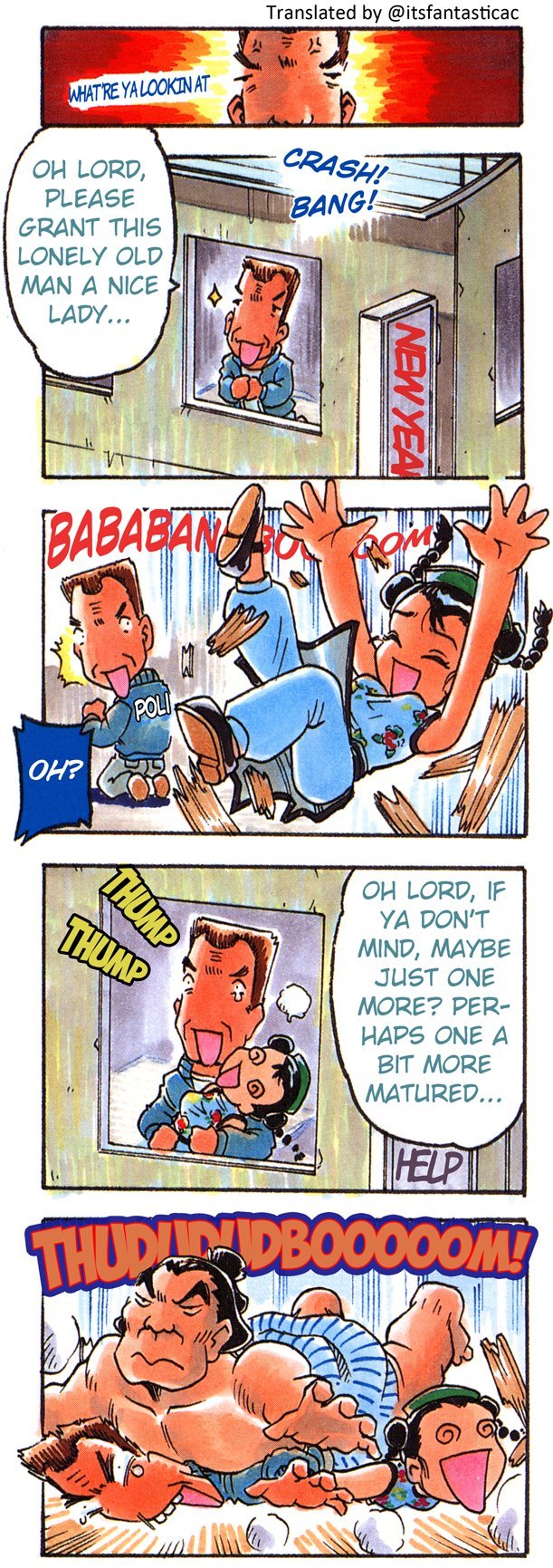#Dynamite Deka / Die Hard Arcade
Explore tagged Tumblr posts
Photo

'Dynamite Deka / Die Hard Arcade' was released on the SEGA Saturn 28 years ago today in Japan. Support us on Patreon
106 notes
·
View notes
Video
tumblr
Sega Ages 2500 Series Vol. 26: Dynamite Deka (Sega - PS2 - 2006)
#Sega Ages 2500#Sega Ages#Dynamite Deka#Die Hard Arcade#AM1#Sega#PS2#PlayStation 2#Sega Titan#beat em up#Tyris Flare#Golden Axe#zplayz
26 notes
·
View notes
Text
SEGA Saturn Collection Game Volume Six: Shining Radiance - Voting Poll













#Sega Saturn#Shining Force#Sakura Wars (Series)#Wrinkle River Story#Dynamite Deka (Die Hard Arcade)#Dark Savior#Hang On#The House of the Dead#Virtua Cop#Voting Poll
4 notes
·
View notes
Text

there's a new post up at the world's greatest obscure videogames review blog, and today's subject is one of those 00s arcade games that sega seem content to leave in limbo forever! go and read about it~!
and please show your support by reblogging this post and maybe also subscribing on patreon for early access to new posts, more screenshots of every game i cover, and various other nice bonuses :D
16 notes
·
View notes
Text
Retro Gaming Ads Blast – Part 7 (Sega Special)
Welcome back readers, fellow geeks and electronic gaming fans! In this edition of the Retro Gaming Ads Blast (RGAB) series, we will examine print ads of Sega from the 1990s which was a notable period of time when they went from being a prominent video game company into a desperate, struggling entity by the end of the decade. All the Sega ads in this edition are promotions of their own video…

View On WordPress
#1990s#32X#advert#advertisement#advertisements#advertising#adverts#America#amusement#Asia#Blog#blogger#blogging#Bruce Willis#Capcom#Carlo Carrasco#console#console gaming#consoles#Die Hard#Die Hard Arcade#diversity#Dreamcast#Dynamite Deka#electronic gaming#entertainment#entertainment blog#Eternal Champions#Europe#fantasy
3 notes
·
View notes
Text
Sega Saturn - Dynamite Deka (Die Hard Arcade)
Title: Dynamite Deka / ダイナマイト刑事
Developer/Publisher: Sega AM1 / Sega Technical Institute
Release date: 24 January 1997
Catalogue No.: GS-9122
Genre: 3D Side-Scrolling Action


One of my favorite games on the Saturn and far better than the Dreamcast sequel, I think. This game was released in the west under the name of Die Hard Arcade just in case you thought it looked familiar. Dynamite Deka hasn't got the most original story ever with its 'save the president's daughter from Mr. Big' scenario but it sure plays great which will have you forgetting the story in no time.
You take the role of one of two undercover badass detectives. One of which looks uncannily like Bruce Willis from Die Hard from the cover illustration. Now if that wasn't bad enough, Mr. Big is holding the president's daughter at the top of a skyscraper that looks dangerously close to the Nakatomi Tower from Die Hard. I'm not sure if Sega had any type of license for this release but if they didn't, they were sure treading on dangerous ground with the many likenesses (^o^;). Everything about Dynamite Deka just shouts out quality. If you have never played this game, then you're missing out on some top-quality fighting action. What more could you ask for? Beating the crap out of bad guys with your fists, feet, or basically anything you can see laying around. You can even make a flame thrower out of an aerosol can and lighter!
Oh, I almost forgot to tell you about the mini-bonus game. The main guy behind Dynamite Dekka was also the guy behind Sega's very old Submarine game. Back in the days when games were more than basic. As a special bonus, this game has been added to Dynamite Deka. Give it a blast to see how games were in the early 80's.



youtube
5 notes
·
View notes
Text
Hmm…do you ever think about how Project X Zone technically has a movie character in the cast?
Okay so basically there's this game by Sega called Dynamite Deka, which was called Die Hard Arcade overseas, making it a licensed game based on the film of the same name. The reasoning for that is because Sega does not have the rights the Die Hard movie in Japan.

That is why Die Hard Arcade got turned into an original IP in Japan titled Dynamite Deka, and John McClane became an original character named Bruno Delinger.
Plus, Bruno's outfit was changed in the international version of Project X Zone in order to avoid any resemblance to Bruce Willis, the actor behind John McClane
Photo 1: Bruno's design in the original Japanese version Photo 2: Bruno's design in the international version


So, yeah. In conclusion: Yes, Project X Zone in fact, technically has a character from a movie.
Oh and you want to know something funny? Ben Hiura, the voice actor of Bruno Delinger, is also the Japanese voice actor of the characters portrayed by Bruce Willis. I just thought I wanted to share that piece of info because it's kind of relevant LOL
In fact, some PXZ fans even call Bruno "Bruce Willis" because of the uncanny resemblance he has LOL
#ganessa says stuff#project x zone#pxz#bruno delinger#okay that's my useless pxz fact of the day LOL
1 note
·
View note
Photo


Virtua Fighter 3/Dynamite Deka (Die Hard Arcade) comics by Takafumi Sotoma, from a 1997 Comic Gamest compilation.
37 notes
·
View notes
Photo

Cindy Holiday from Dynamite Deka (aka Die Hard Arcade).
50 notes
·
View notes
Photo

#die hard arcade#dynamite cop#dynamite deka#sega saturn#sega#golden axe#altered beast#megadrive#sega genesis#retro gaming#90s
27 notes
·
View notes
Link
Die Hard Arcade is a 3D beat `em up originally developed for the Sega ST-V and ported to the Sega Saturn.
Check out our review, screenshots, a full catalog of all of the related merchandise, and more here: https://segascream.com/die-hard-arcade/
19 notes
·
View notes
Photo

'Dynamite Deka / Die Hard Arcade' was released on the SEGA Saturn 27 years ago today in Japan.
350 notes
·
View notes
Video
tumblr
Sega Ages 2500 Series Vol. 26: Dynamite Deka (Sega - PS2 - 2006)
#Dynamite Deka#Sega Ages#Sega Ages 2500#PS2#zplayz#PlayStation 2#Sega#beat em up#Tyris Flare#Golden Axe#Die Hard Arcade#sega life#AM1
24 notes
·
View notes
Photo

Dynamite Deka 2 (aka Dynamite Cop) Original Soundtrack by Sega
#Dynamite deka 2#Dynamite deka#Dynamite cop#Sega#Arcade#Sega naomi#Sega dreamcast#Dreamcast#Die hard arcade#Wolf hongo#beat em up
21 notes
·
View notes
Photo


dynamite deka article from sega saturn magazine #22
19 notes
·
View notes
Note
Hans Gruber from Die Hard!!


Hans Gruber has a Ryu Number of 4/3.
(explanation below)
Yes, that is the same image for John McClane and Bruno Delinger. There's some semantics to work through.

Dynamite Deka is a game developed by Sega and released in arcades around July 1996 starring a blue-jacketed fellow named Bruno Delinger as one of the playable characters. It was released next month in North America as Die Hard Arcade starring a blue-jacketed fellow named... John McClane. You know, as in Die Hard's John McClane.
So there's a regional difference in naming. Precedence with Herlock Sholmes/Sherlock Holmes for Ryunosuke Naruhodo's Ryu Number might suggest that Delinger and McClane should be treated as the same character, which would give Hans Gruber a Ryu Number of 2.
However, I would argue otherwise. Sega released a sequel to Dynamite Deka, which was localized as Dynamite Cop, lacking the Die Hard licensing and John McClane altogether. As a result, Bruno Delinger exists in another game independent of John McClane, so asserting that they are one and the same becomes considerably dodgier.

Put simply, even if it is fair to say Bruno Delinger and John McClane are in Dynamite Deka/Die Hard Arcade, I think it is fair to say that Bruno Delinger is not in Die Hard for the NES and John McClane is not in Project X Zone.


So they're not the same character. But they could still be in the same game, which would give Hans Gruber a Ryu Number of 3.
To that end, I'm going to appeal to semantics. The character named "Bruno Delinger" and the character named "John McClane" never appear in the same game. Delinger is in Dynamite Deka and McClane is in Die Hard Arcade, but there exists of no build of either game where both are present. They're mutually exclusive, in other words.
I will grant that this line of reasoning is less bulletproof, which is why I included the 3 above. For the record, though, 4 feels more correct to me, whatever that's worth.
26 notes
·
View notes